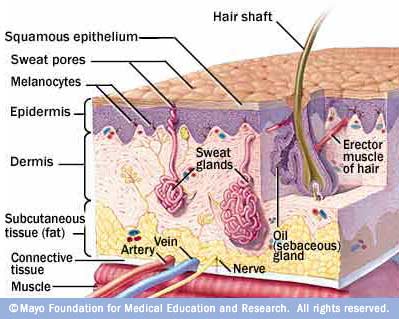The other posts this week wanted me to find an article dealing with a different field of skin transplants, which is how I came across this National Geographic article. This article was written in 2005, which is when this potential technology was first being discovered. "When burns extend over 50 or 60 percent of the body, patients don't have enough of their own skin to cover them." The process will help severely burned patients to faster and better recovery.
 http://www.technologyreview.com/biomedicine/23876/
http://www.technologyreview.com/biomedicine/23876/The technique involves taking a small patch of the patient's healthy skin cells and growing them in a lab to then be sprayed on the patient. Since this technology is still undergoing development, its full potential is still not known. The article discusses research trials being done to test the spray-on skin cells ability to fill in the holes of normal skin grafts. The research was testing whether burn victims that were then treated with the spray-on skin recovered faster than just normal skin grafts. While I am having difficultly finding the results of this research, the importance of this development was expressed in this article.
"The average hospital stay for a burn victim can cost up to $3,680 (U.S.) per day and can last for about two weeks. In contrast, a single spray treatment can cost about $9,000 (U.S.)." This financial advantage is just one positive to the new technology. It has also been shown that the faster recovery for the burn victims helps to reduce the severity of the scar tissue.
More research into this new biotechnology innovation led to some other interesting concepts that could possibly develop. One creative innovation would be a "spray-on gun," which is quickly discussed in the link below. This would allow skin cells to instantly be applied to wounds, such as for soldiers that undergo battle wounds. The following link is about Dr. Fiona Wood (Dr. Fiona Wood), the doctor that discovered this innovation. The article is worth reading to see how important her research is:
"Following her work done for victims of the terrorist attack in Bali, Dr Fiona Wood's unique solution for burns victims has attracted worldwide acclaim. Currently Director of the West Australian Burns Service and co-founder/Director of Clinical Cell Culture Ltd, this pioneering doctor's technique known as 'spray-on skin,' helped to substantially reduce the death toll of the Bali bombings. Wood's method allows for the rapid administration of skin cells, speeding up the healing process and significantly reducing scarring. Where previous techniques of skin culturing required 21 days to produce enough cells to cover major burns, Wood's innovative technique has cut this time to 5 days. "
Spray-On Skin Cell Gun
